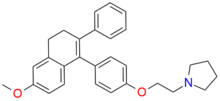Nafoxidine
 | |
| Clinical data | |
|---|---|
| ATC code | none |
| Identifiers | |
| |
| CAS Number | 1845-11-0 |
| PubChem (CID) | 4416 |
| IUPHAR/BPS | 4263 |
| ChemSpider | 4263 |
| UNII |
4RIY10WM82 |
| ChEMBL | CHEMBL28211 |
| ECHA InfoCard | 100.222.756 |
| Chemical and physical data | |
| Formula | C29H31NO2 |
| Molar mass | 425.562 g/mol |
| 3D model (Jmol) | Interactive image |
| |
Nafoxidine (INN) (developmental code names U-11,000A, NSC-70735), or nafoxidine hydrochloride (USAN), is a non-steroidal selective estrogen receptor modulator (SERM) or partial antiestrogen of the triphenylethylene group that was developed for the treatment of advanced breast cancer by Upjohn in the 1970s but was never marketed.[1][2][3] It was developed at around the same time as tamoxifen and clomifene, which are also triphenylethylene derivatives.[2] The drug was originally synthesized by the fertility control program at Upjohn as a postcoital contraceptive, but was subsequently repurposed for the treatment of breast cancer.[4] It showed clinical effectiveness in breast cancer,[5] but development was terminated due to the incidence of severe photophobia.[4][6]
References
- ↑ J. Elks (14 November 2014). The Dictionary of Drugs: Chemical Data: Chemical Data, Structures and Bibliographies. Springer. pp. 848–. ISBN 978-1-4757-2085-3.
- 1 2 JORDAN V. CRAIG; B.J.A. Furr (5 February 2010). Hormone Therapy in Breast and Prostate Cancer. Springer Science & Business Media. pp. 95–96. ISBN 978-1-59259-152-7.
- ↑ Georg F. Weber (22 July 2015). Molecular Therapies of Cancer. Springer. pp. 361–. ISBN 978-3-319-13278-5.
- 1 2 Hormones and Breast Cancer. Elsevier. 25 June 2013. pp. 32–. ISBN 978-0-12-416676-9.
- ↑ Steinbaum, Fred L.; de Jager, Robert L.; Krakoff, Irwin H. (1978). "Clinical trial of nafoxidine in advanced breast cancer". Medical and Pediatric Oncology. 4 (2): 123–126. doi:10.1002/mpo.2950040207. ISSN 0098-1532.
- ↑ Aurel Lupulescu (24 October 1990). Hormones and Vitamins in Cancer Treatment. CRC Press. pp. 95–. ISBN 978-0-8493-5973-6.